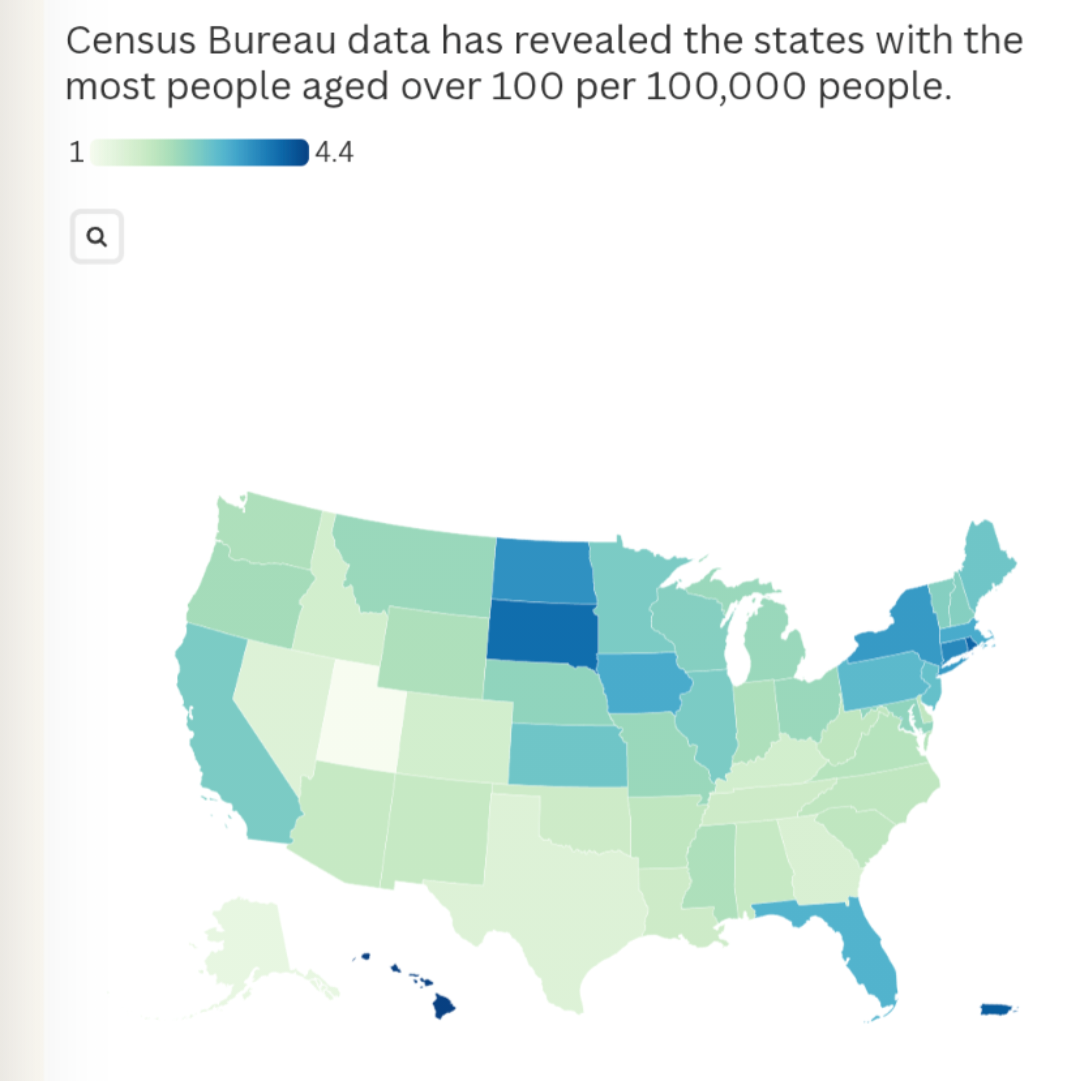Centenarians by U.S. State Map


Alex Cartwright
Senior Cartographer & GIS Specialist
Alex Cartwright is a renowned cartographer and geographic information systems specialist with over 15 years of experience in spatial analysis and data...
Geographic Analysis
What This Map Shows
The map titled "U.S. States With the Most Centenarians" visually represents the distribution of individuals aged 100 years and older across different states in the United States. This visualization provides a clear snapshot of where the oldest segments of the population reside, highlighting not only sheer numbers but also the concentrations of centenarians in various regions. This data is crucial for understanding demographic trends and the factors that contribute to longevity in different states.
Deep Dive into Centenarians
Centenarians—individuals who have reached the remarkable milestone of 100 years—represent a unique segment of the population that has garnered increasing interest in demographic research. The study of centenarians offers insights into aging, health trends, and the impacts of lifestyle and environment on longevity. Interestingly, as of recent statistics, there are over 90,000 centenarians in the United States, a figure that has steadily risen over the past few decades. This increase can be attributed to advancements in healthcare, improved living conditions, and increased awareness of healthy lifestyles.
What’s fascinating is that certain states have higher concentrations of centenarians. For instance, California, Florida, and New York often top the list due to their large populations and favorable climates, which might contribute to longer life spans. However, it’s not just about the numbers; the lifestyle choices and health resources available in these states play a significant role. States like Hawaii and Colorado also rank high in centenarian populations, likely due to their focus on outdoor activities, healthy diets, and holistic wellness approaches.
Demographically, centenarians are predominantly female, with women making up approximately 80% of this age group. This trend could be linked to biological factors, social networks, and lifestyle choices that favor longer life for women. Furthermore, the health conditions of centenarians reveal noteworthy patterns. Many centenarians report maintaining an active lifestyle into their later years, engaging in physical and mental activities that keep them sharp and healthy.
Aging research has also highlighted the concept of "Blue Zones," regions of the world where people live significantly longer than average. Interestingly, the U.S. has its own Blue Zone in Loma Linda, California, where a community of Seventh-day Adventists enjoy longevity due to their vegetarian diet and strong community bonds.
Regional Analysis
Analyzing the map, we can see distinct regional variations in the population of centenarians. For example, the West Coast, particularly California, not only boasts a high number of centenarians but also a diverse demographic mix that contributes to different health practices and lifestyles. In contrast, states in the Midwest and the South, such as Iowa and Texas, show varying averages of centenarians, often influenced by socio-economic factors and access to healthcare.
Interestingly, the Northeast also has notable concentrations of centenarians. States like Massachusetts and New Jersey have robust healthcare systems and a high standard of living, which contribute to longevity. However, these states face challenges such as high costs of living and variability in health outcomes based on urban versus rural settings.
Comparing urban versus rural areas, urban centers often provide better access to healthcare services and social activities, which could explain the higher numbers of centenarians in cities. However, rural areas sometimes have tight-knit communities that can also support healthy aging through social connections and lower stress levels.
Significance and Impact
Understanding the distribution of centenarians is crucial for several reasons. First, it helps policymakers and healthcare providers address the needs of an aging population. With the baby boomer generation reaching advanced age, the implications for healthcare systems, social services, and community planning are profound. As the number of centenarians continues to rise, there will be increased demand for age-appropriate services, from healthcare to housing.
Moreover, researching why certain states foster higher numbers of centenarians can lead to broader insights into health promotion and disease prevention strategies. It encourages a vital examination of lifestyle factors, healthcare access, and community structures that support healthy aging. Future projections suggest that as healthcare continues to evolve and improve, the number of centenarians may rise even further, making it essential for society to prepare for this demographic shift.
In conclusion, the map of U.S. states with the most centenarians offers a fascinating glimpse into the lives of some of the oldest among us. It invites us to consider what contributes to their longevity and how we can apply those lessons to enhance the quality of life for future generations. Ever wondered how your state compares? It’s a reminder that geography doesn’t just shape where we live—it profoundly influences how long we live as well.
Visualization Details
- Published
- September 30, 2025
- Views
- 34
Comments
Loading comments...